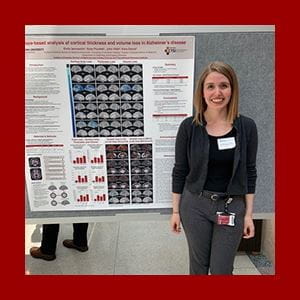“Medicine is an interesting field and offers many opportunities to help people,” Indiana University School of Medicine–Evansville student Emily Iannopollo, Class of 2023, says of her decision to leave an established career in information technology to study medicine.
“My time at IU School of Medicine has been very rewarding. I have had opportunities that I never imagined when I initially applied to medical school,” she said.
Those opportunities include authoring a paper published in a respected medical journal with findings from her analytical work in the field of Alzheimer’s disease. What started as a summer research project gained traction during Iannopollo’s MedSTAR fellowship,
The one-year MedSTAR program provides participants with mentored clinical and translational research opportunities. Iannopollo is the first Evansville student to complete MedSTAR, which accepts up to four IU School of Medicine students each year.
Medical school was not always a part of Iannopollo’s plan. After receiving her undergraduate degree in computer information systems, she spent five years working in the IT sector.
Living in Evansville, Iannopollo was impressed with IU School of Medicine’s presence there.
“The more I learned about IU School of Medicine’s curriculum and the opportunities available at IU School of Medicine, the more excited I was to attend IU,” she said.
Her transition to medical school presented challenges, but Iannopollo credits her classmates and the faculty at IU School of Medicine-Evansville, along with her fiancé, with providing the support and encouragement needed for her to excel throughout her journey.
In 2019, when Kara Garcia, PhD, ME, was looking for students with programming experience for the Indiana University Medical Student Program for Research and Scholarship (IMPRS), Iannopollo saw an opportunity to leverage her analytical skills and interest in research. The research project she started during the summer IMPRS program led Iannopollo to apply for MedSTAR.
Garcia and Iannopollo continued their work together during MedSTAR. They used a technique Garcia helped develop called anatomically-constrained Multimodal Surface Matching (aMSM). Previously Garcia had used the method to track the growth of the cerebral cortex in infants. However, it was Iannopollo’s research that first used the technique to track atrophy.
“Our results are very promising and show some advantages over other commonly used methods of tracking atrophy over time. We hope that it will prove useful in the study of Alzheimer’s disease and other neurodegenerative diseases,” Iannopollo said.
Her research culminated in submission of her first research paper, published by the Journal of Human Brain Mapping and titled, “Enhanced detection of cortical atrophy in Alzheimer’s disease using structural MRI with anatomically-constrained longitudinal registration.”
“By continuing her IMPRS work into MedSTAR, Emily was able to move her initial summer project to publication, earning a first-author publication in a well-respected journal. And she was able to make good progress on a new, second project that will likely lead to publication,” said Garcia.
Shannon L. Risacher, PhD, served as an additional MedSTAR mentor for Iannopollo. To further Iannopollo’s research, Risacher introduced her to a research group which has defined different subtypes of Alzheimer’s disease based on patients’ predominant symptom type(s) at the time of diagnosis: memory, language, executive function and visuospatial.
“We are hopeful that, by applying aMSM to these subtypes, we will be able to determine whether they have different trajectories of cortical atrophy,” Iannopollo said of the research group. “We hope that our findings will add to the evidence that there are biological differences between the Alzheimer’s subtypes. Such differences could have implications for the future of Alzheimer’s treatment and drug development, allowing for more targeted and personalized solutions.”
As Iannopollo progresses through her medical school career, her mentors look forward to what she will accomplish in the future.
“Honestly, I cannot say enough about what a great student Emily has been from the start and what a great researcher she has become,” Garcia said. “I truly feel she could do just about anything she sets her mind to, but I selfishly hope she continues her path toward neurology and research—and possibly landing back in Southwest Indiana—so we can continue to work as colleagues in the years to come.”
